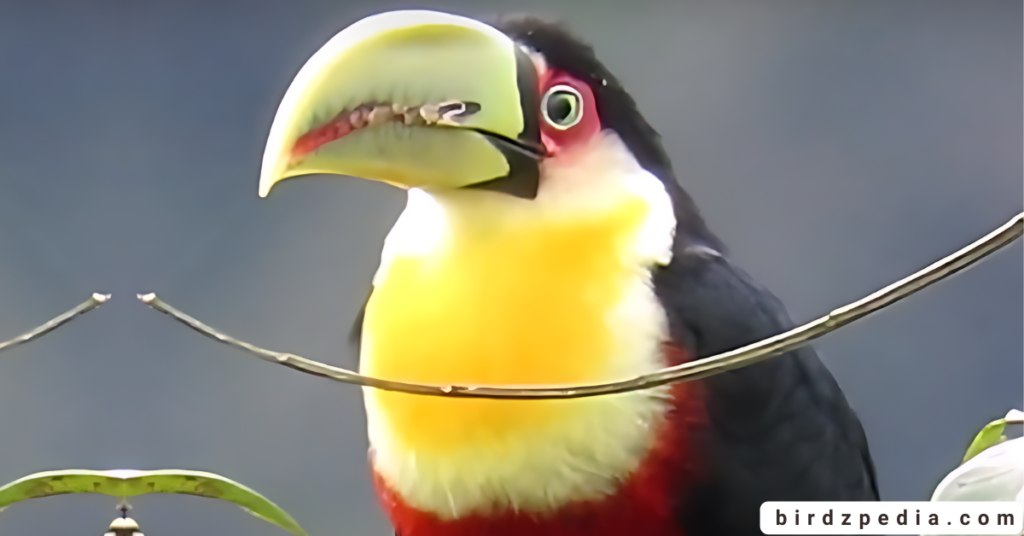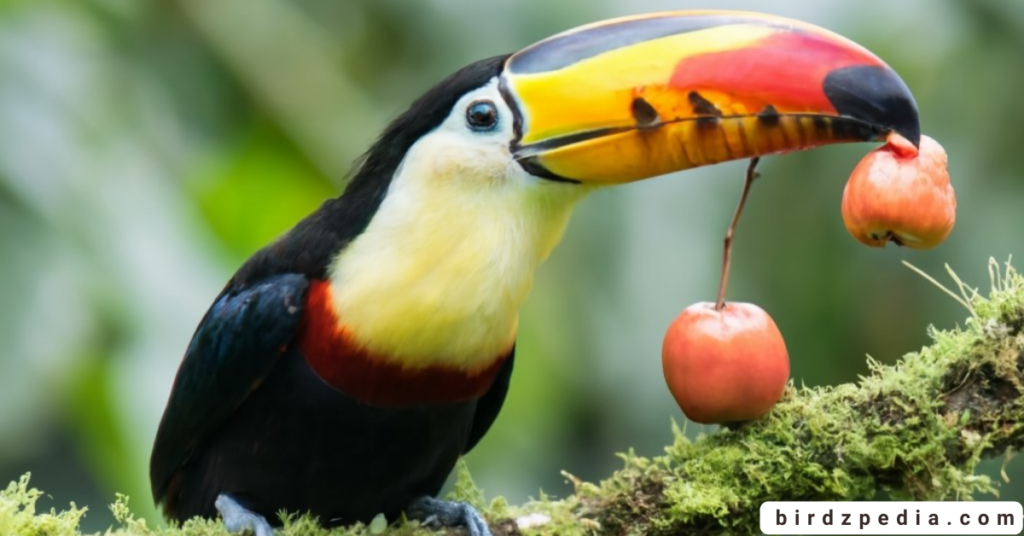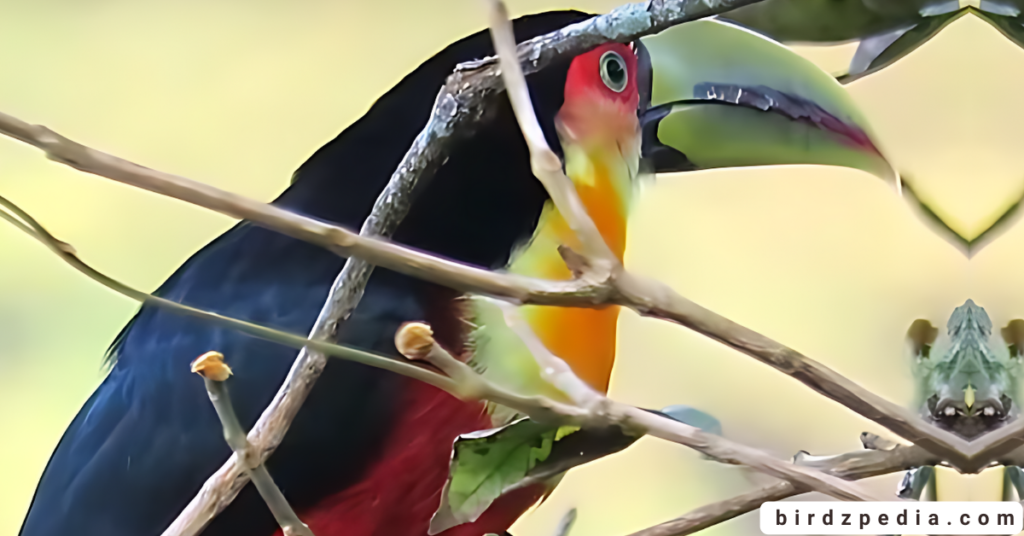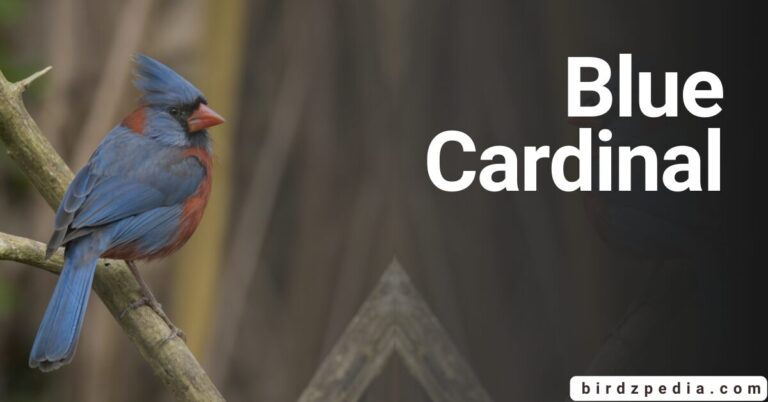Red-Breasted Toucan: [Ramphastos dicolorus] A Symphony of Colors
Scientific Classification
| Kingdom | Phylum | Subphylum | Class | Order | Family | Genus | Species |
|---|---|---|---|---|---|---|---|
| Animalia | Chordata | Vertebrata | Aves | Piciformes | Ramphastidae | Ramphastos | dicolorus |
Red-Breasted Toucan
The Red-breasted Toucan, or Ramphastos dicolorus in scientific parlance, is a member of the family Ramphastidae of avian species, which also includes toucanets and aracaris. This bird, which is native to Bolivia, Paraguay, Brazil, Argentina, and other places,
is distinguished by its greenish bill and vivid red breast. It is a prominent representative of the varied birdlife present in South America’s expansive and biologically diverse regions.

Summary
- Species Name: Ramphastos dicolorus
- Family: Ramphastidae (toucanets, aracaris, and toucans)
- Distribution: located in Bolivia, Paraguay, Brazil, Argentina, and Bolivia
- Physical Features: Black top portions, greenish bill, and bright red breast.
- Size: regarded as the Ramphastos genus’s smallest species.
- Habitat: inhabits Pantanal savanna, second-growth scrub, and tropical and subtropical montane and submontane forests.
- Conservation Status: designated as “Least Concern,” despite the fact that the population is declining.
- Distinctive Traits: renowned for making loud noises, such as croaking, barking, and bugling sounds.
- Notable Habitat: is visible in locations such as The Dallas World Aquarium.
- Scientific Classification: A portion of the Ramphastidae family, Ramphastos genus, Dicolorus species, Chordata phylum, Aves class, and Piciformes order within the Animalia kingdom.
Taxonomy and systematics
| Attribute | Information |
|---|---|
| Sister Species | Channel-billed toucan (R. vitellinus) and Choco toucan (R. brevis) |
| Monotypic Status | Yes (The Ramphastos dicolorus is monotypic) |

Description
The length and weight of the Ramphastos dicolorus range from 42 to 48 cm (17 to 19 in) and 265 to 400 g (9.3 to 14 oz). Being the smallest member of the genus Ramphastos, the male and female animals are identical in appearance, with the exception that the female usually has a little shorter beak than the male.
Their bill is mostly green to green-yellow in color, with a characteristic black vertical line at the base, red and ivory tomial “teeth,” and faint green striations on the maxilla. With the exception of red uppertail coverts, the bird’s crest, neck, upperparts, and tail are primarily black. The face is particularly striking in
that it is predominantly yellow, with sparse patches of red, blue, and yellow-green skin around each eye. The breast and throat are yellow, and there is a noticeable red area in the lower breast. Moreover, the flanks are primarily black, but the belly and undertail coverts have a striking red tint.

Distribution and Habitat
- They are found in Tocantins, Minas Gerais, and Espírito Santo in south-central, east-central, and southeastern Brazil, extending through eastern Paraguay, Bolivia, and into northern Argentina’s Formosa, Chaco, Corrientes, and Misiones provinces.
- It predominantly resides in subtropical and tropical, sub-montane, and montane forests but is also present in scrublands, savannas with trees, and plantations.
- The typical elevation range for this toucan is between 100 and 1,500 m (300 and 4,900 ft).
- Although it can occur as high as 2,070 m (6,800 ft), such instances are rare.
Behavior
Food
The main source of food for them is fruit, which includes both native and invasive plant species, as well as green coffee beans and orchard fruits. It also includes, though to a lesser degree, insects and small birds in its diet. Foraging is usually done in pairs or small groups,
though occasionally there are gatherings of twenty or more people. During its eating activities, the toucan is known to pick up fallen fruits from the ground, even though its preferred foraging habitat is the forest canopy.

Breeding
In the southern portion of its territory, they breeds from October to February; in the northern portion, the mating season runs from January to June. In the course of breeding, males exhibit wooing behaviors such allopreening and feeding the females, and pairs set territorial borders.
Woodpecker-excavated or naturally-occurring cavities in live and dead trees are used for nesting. It is known that the species will extend the hollow as well as the entrance hole as needed. Seeds that have been discharged usually collect on the bottom of the cavity. Nests have been seen a few times, and their
heights range from 0.7 to 6.0 m (2 to 20 feet) above the earth. There are two to four eggs in each clutch. The two adult birds take turns caring for the nestlings and incubating the eggs. Approximately 16 to 19 days pass during the incubation phase, and 40 to 50 days after hatching, the birds begin to fly.
Species in same Genus
| Genus | Species | Scientific Name |
|---|---|---|
| Ramphastos | Red-breasted Toucan | Ramphastos dicolorus |
| Ramphastos | Channel-billed Toucan | Ramphastos vitellinus |
| Ramphastos | Choco Toucan | Ramphastos brevis |
Movement
In the southern portion of its habitat, the Ramphastos dicolorus tends to move to lower elevations, especially in the austral winter. Some go to plantations after the mating season from their natural forest habitats.

Sounds
The “croaker” group of toucans includes the Ramphastos dicolorus. One of its characteristic “loud, raucous ‘WRèh‘ or ‘niuh‘” songs is part of its vocal repertoire. It also makes additional vocalizations, including “low ‘ek‘, ‘zneep‘, and growl-like begging” sounds, as well as a “long series of noisy honking ‘grrekk‘ notes“. The bird also claps its bills and rattles its tongue inside its bills.
Lifespan
There is insufficient information about their lifespan in the wild. But given that closely related toucan species can live 15 to 20 years in captivity, it is reasonable to believe that they will live a comparable amount of time in its natural habitat.
Speed
They are one of the toucan species that is not renowned for its swiftness or agility in the air. Their flight pattern is usually direct and unhurried. Nevertheless, it is difficult to get precise speed figures for the Ramphastos dicolorus in the literature.
Threats
- Habitat loss due to deforestation.
- Illegal pet trade.
- Climate change affecting their forested habitats.
- Hunting for feathers or traditional medicine.
- Agricultural expansion impacting their natural environment.
- Competition for nesting sites with other bird species.
Common Names in Different Languages
| Language | Common Name |
|---|---|
| English | Red-breasted Toucan |
| Spanish | Tucán Pico Verde |
| Portuguese | Tucano-de-peito-vermelho |
| French | Toucan à poitrine rouge |
| German | Rotbrusttukan |
| Italian | Tucano pettorosso |
| Dutch | Roodborsttoekan |
| Portuguese (BR) | Tucano-de-peito-vermelho |

Status
The red-breasted toucan was formerly listed as Near Threatened by the International Union for Conservation of Nature (IUCN). But it has been reassessed after 2004 and is now classified as Least Concern. Although it has a wide range of distribution, the population size is estimated to be decreasing
but is currently unclear. There are no known threats at this time. The species is found in a number of protected locations and is described as “reasonably common in general.” However, it is occasionally hunted or persecuted outside these zones, especially for eating orchard fruit.
FAQs
- Where is the red-breasted toucan found?
- They are found in Argentina, Brazil, Bolivia, and Paraguay.
- What is the size of Ramphastos dicolorus?
- They are approximately 42 to 48 cm (17 to 19 in) long.
- What does they eat?
- The main sources of food for red-breasted toucans are fruits, insects, and small birds.
- When does they breed?
- In the southern portion of its territory, the Ramphastos dicolorus breeds from October to February, while in the northern portion, it breeds from January to June.
- Is the Ramphastos dicolorus a threatened species?
- It is imperative to verify the most recent evaluations of the conservation status of the Ramphastos dicolorus, as it can differ. It was not seen as a worldwide threat as of January 2022, when I last updated my understanding.
- What is the lifespan of a Ramphastos dicolorus?
- Their lifespans vary, but captive animals can reach 20 years of age.
- What is their habitat?
- The subtropical and tropical woods, sub-montane and montane regions, scrublands, tree-filled savannas, and plantations are home to the Ramphastos dicolorus.
- How does the Ramphastos dicolorus communicate?
- Among the many vocalizations used by them to communicate include a loud, boisterous ‘WRèh‘ or ‘niuh‘, as well as other honking and growling-like noises.


![Yellow-rumped Cacique [Cacicus cela] Guide Food, Habitat, Sound:](https://birdzpedia.com/wp-content/uploads/2023/12/Untitled-design-80-768x402.png)
![Black Skimmer [Rynchops niger], Diet, Predators, and Characteristics](https://birdzpedia.com/wp-content/uploads/2023/12/Black-Skimmer-768x402.png)
![Exploring The Neotropic cormorant[Nannopterum brasilianum]](https://birdzpedia.com/wp-content/uploads/2024/01/Neotropical-cormorant-768x402.jpg)

![Verreaux’s Eagle [Aquila verreauxii] Overview, Habitat, Sounds](https://birdzpedia.com/wp-content/uploads/2023/12/Black-Oystercatcher-768x402.png)
